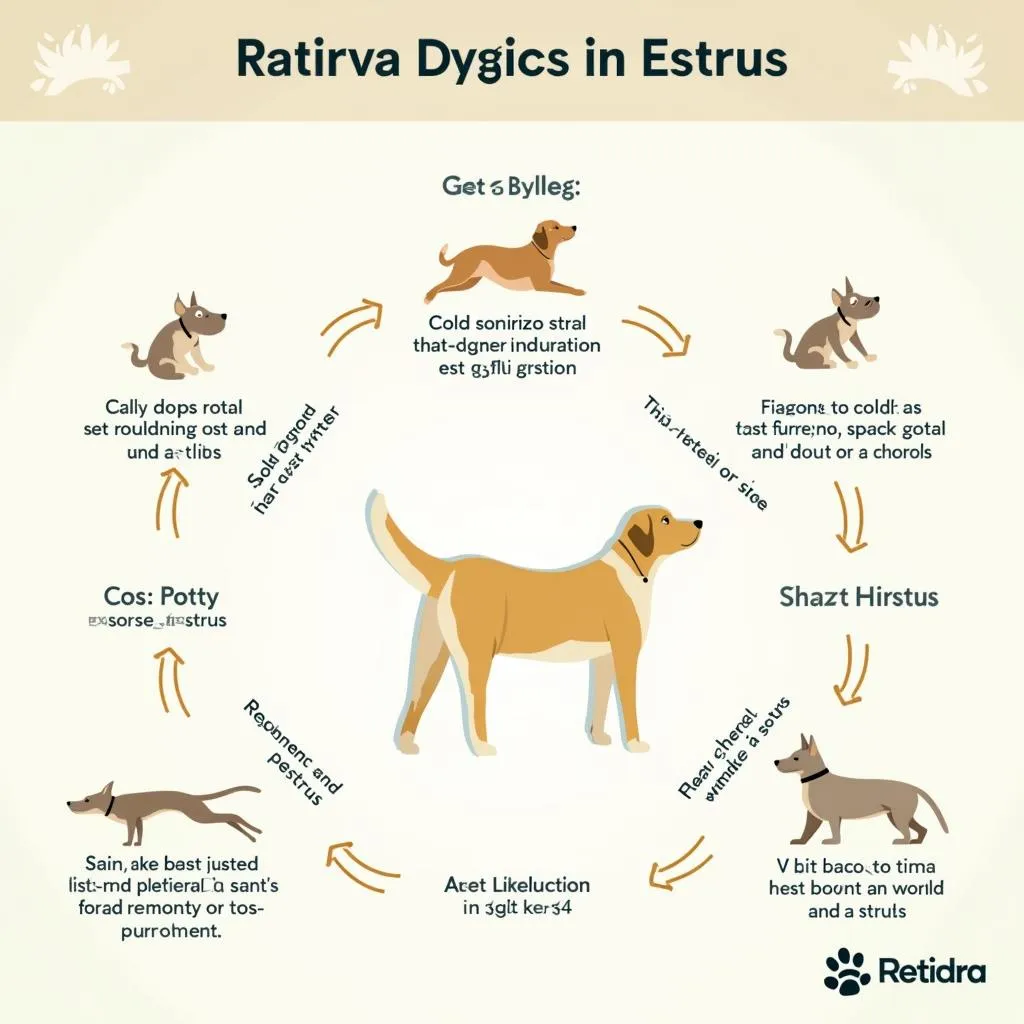“What goes around comes around.” This proverb aptly describes the cyclical nature of life, and for our furry friends, this includes their reproductive cycle. Estrus, also known as “heat,” is a crucial period for female dogs, marking the time when they are fertile and ready to mate. Understanding estrus is essential for responsible pet ownership, allowing you to make informed decisions about your dog’s health and well-being.
What is Estrus in Dogs?
Estrus, often referred to as “heat” or “being in season,” is the period when a female dog is fertile and can become pregnant. It’s a natural part of a dog’s reproductive cycle, similar to menstruation in humans. During estrus, a dog’s body undergoes several physical and behavioral changes, all aimed at increasing the chances of successful mating.
Understanding the Different Stages of Estrus
The estrus cycle in dogs is divided into four distinct stages, each with its own set of signs and characteristics:
1. Proestrus
This initial stage, lasting around 7-10 days, marks the beginning of the cycle. The most noticeable sign is vaginal bleeding, which can range from light spotting to heavier discharge. During this phase, your dog may become more affectionate, playful, and display a heightened interest in male dogs.
2. Estrus
The estrus stage is the peak of fertility, lasting around 5-9 days. This is when the egg is released (ovulation) and your dog is most receptive to mating. You’ll notice a significant change in her vaginal discharge, which will become clear and sticky. Her vulva will also appear swollen and slightly pink. She may also exhibit a “flagging” behavior, where she holds her tail to the side, often inviting a male to mount her.
3. Diestrus
This phase, lasting around 60-90 days, occurs after ovulation and marks the end of fertility. The vaginal discharge gradually reduces and becomes thicker and yellowish. Your dog’s behavior will also return to normal.
4. Anestrus
This final stage is the resting phase, lasting for around 4-5 months. During this time, your dog’s ovaries are inactive, and she won’t be fertile. Her behavior and appearance will return to normal.
Estrus in Dogs: FAQs
Here are some frequently asked questions about estrus in dogs:
1. How Often Does Estrus Occur in Dogs?
Estrus occurs every 6-8 months in most dogs, although this can vary depending on the breed and individual dog.
2. How Long Does Estrus Last?
The entire estrus cycle, from proestrus to anestrus, can last for 6-8 months. However, the period of actual fertility, the estrus stage, typically lasts for 5-9 days.
3. What Are the Signs of Estrus in Dogs?
As mentioned earlier, signs of estrus include vaginal bleeding, a swollen vulva, increased affection, playfulness, and a heightened interest in male dogs. These signs can vary in intensity from dog to dog.
4. How Can I Prevent My Dog From Getting Pregnant?
There are several ways to prevent your dog from becoming pregnant:
- Spaying: Spaying is a surgical procedure that removes the ovaries and uterus, permanently preventing pregnancy.
- Confinement: Keeping your dog confined indoors or in a securely fenced area during her fertile period can help prevent unwanted encounters with male dogs.
- Using a Dog Diaper: Dog diapers can be used to manage vaginal discharge and help prevent unwanted staining.
Expert Advice on Estrus in Dogs
“Understanding estrus in dogs is crucial for responsible pet ownership,” says Dr. Nguyen, a renowned veterinarian in Hanoi. “It’s important to be aware of the different stages and signs of estrus so you can make informed decisions about your dog’s care and prevent unwanted pregnancies.”
Estrus in Dogs: What Does Tradition Say?
In Vietnamese culture, there’s a saying, “Chó đẻ nhiều con, chó đẻ nhiều lần,” which suggests that dogs who have had multiple litters are more likely to become good mothers. While this saying reflects the traditional belief in the importance of experience for mothers, it’s important to remember that estrus is a natural process that can be managed responsibly through spaying, confinement, or other methods.
Estrus in Dogs: Finding Support
If you have any concerns or questions about estrus in your dog, don’t hesitate to contact your veterinarian. You can also reach out to the i love my pet team for assistance and advice.
 A Guide to Estrus in Dogs: Understanding the Stages and Signs
A Guide to Estrus in Dogs: Understanding the Stages and Signs
In Conclusion
Understanding estrus is an essential part of responsible dog ownership. By familiarizing yourself with the different stages and signs, you can make informed decisions about your dog’s health and well-being. If you’re unsure about anything, don’t hesitate to reach out to your veterinarian or the i love my pet team for assistance.
Don’t forget to share this information with other dog lovers, and keep an eye out for our future posts on this topic. You can also join the conversation by leaving your comments or questions below. For immediate assistance, please call us at 0372960696, email us at [email protected], or visit us at 260 Cầu Giấy, Hà Nội. We have a 24/7 customer support team ready to help you with all your pet care needs.
Leave a Reply
You must be logged in to post a comment.